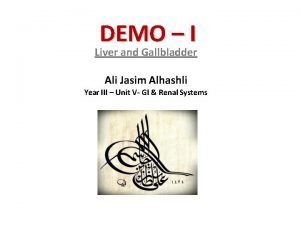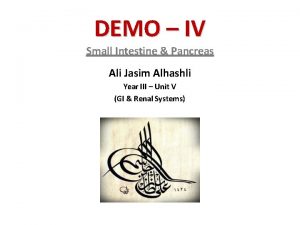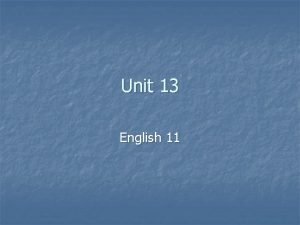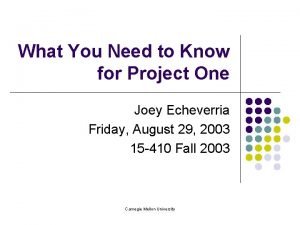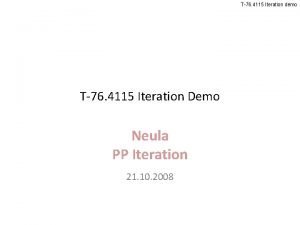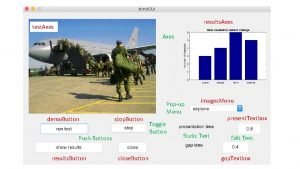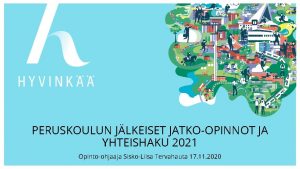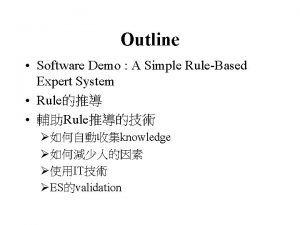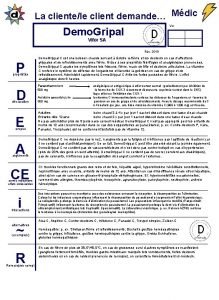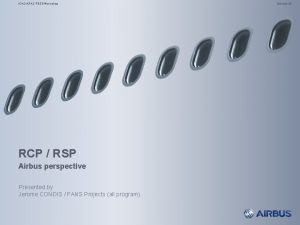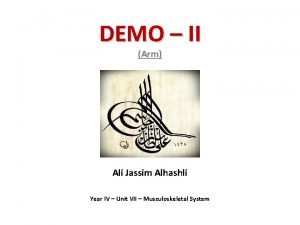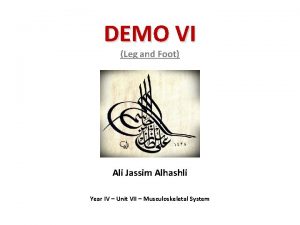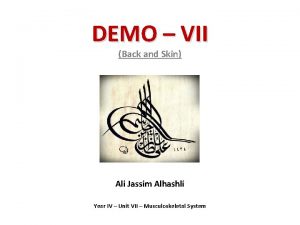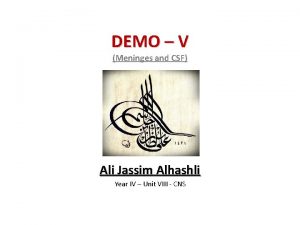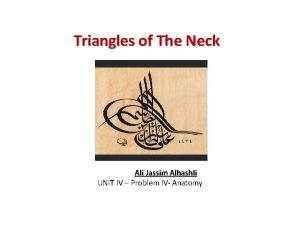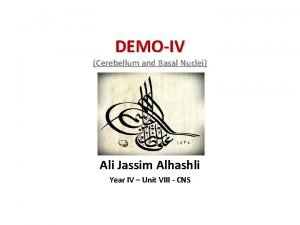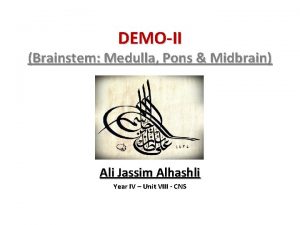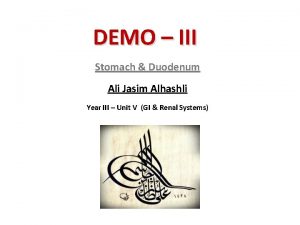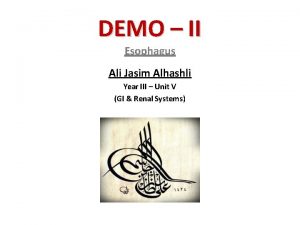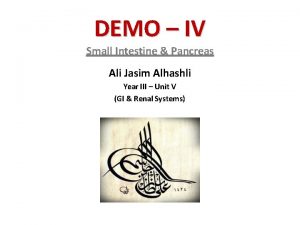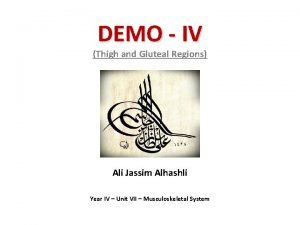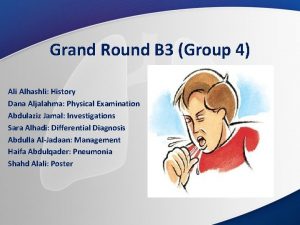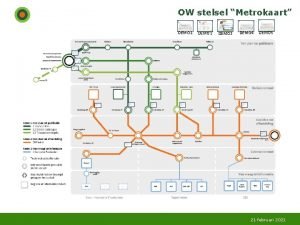DEMO I Ali Jassim Alhashli Year II Unit



























- Slides: 27

DEMO – I Ali Jassim Alhashli Year II – Unit I (Man and His Environment)

STATION – 1 (Autonomic Nervous System) • The nervous system is classified to: – Central Nervous System (CNS): which includes brain and spinal cord. – Peripheral Nervous System (PNS): which transport signals from an to the CNS and is further classified to: • Sensory component: including somatic nerves (for sensation of pain) and visceral nerves. • Motor component: including somatic nerves (for voluntary movements) and visceral nerves.

STATION – 1 (Autonomic Nervous System)

STATION – 1 (Autonomic Nervous System)

STATION – 1 (Autonomic Nervous System) • White ramus → pre-ganglionic fibers → myelinated (have myelin sheath around their axons thus appearing white due to the presence of fat in myelin). • Grey ramus → post-ganglionic fibers → un-myelinated (do not have myelin sheath around their axons). • Sympathetic nerve fibers originate from: – T 1 to L 2/L 3 (thoracolumbar origin). • Parasympathetic nerve fibers are: – CN III: oculomotor nerve. – CN VII: facial nerve. – CN IX: Glossopharyngeal nerve. – CN X: vagus nerve. – And also from S 2, S 3, S 4 – (craniosacral origin).

STATION – 1 (Autonomic Nervous System) • • In sympathetic and parasympathetic nervous systems: – Ganglia: are collection of nerve cell bodies outside brain and spinal cord. – Nuclei: are collection of nerve cell bodies inside brain and spinal cord. Sympathetic nervous system is activated for “fight-or-flight” response while parasympathetic nervous system is activated at rest condition. Effects of both systems on the body are explained in the table below.

STATION – 1 (Autonomic Nervous System) • • In sympathetic nervous system: – Sympathetic fibers synapse in paravertebral ganglia. – Or synapse in the prevertebral ganglia which is located near the major abdominal arteries: • Greater splanchnic nerve. • Lesser splanchnic nerve. • Least splanchnic nerve. – Or continuing as a white ramus without synapsing (example: adrenal gland medulla which functions as a sympathetic ganglia). What is the difference between radiating and referred pain? – Radiating pain: extension of pain from original site to another site with persistence of pain at original site (e. g. penetration of duodenal ulcer posteriorly causes pain both in epigastrum and back; pancreatitis radiated to back). – Referred pain: pain is not felt at the site of disease but felt at a distant site (e. g. diaphragmatic irritation causes referred pain at the tip of shoulder through same segmental supply. Diaphragm (phrenic nerve C 3, C 4, C 5); shoulder (cutaneous supply C 5, C 5).

STATION – 2 (Planes of Movement) • What are the planes of movement? – Sagittal plane: which is further divided into right and left sagittal planes. – Fontal (coronal) plane: which is further divided into anterior or posterior planes. – Transverse (horizontal) plane: which is further divided into upper and lower planes. • What are the axes of movement? – Sagittal axis: where sagittal and transverse planes meet. – Frontal axis: where frontal and transverse planes meet. – Vertical axis: where sagittal and frontal planes meet. Notice that both sagittal and frontal axes allow transverse movement.

STATION – 2 (Planes of Movement)

STATION – 2 (Planes of Movement) • Types of movement: – Flexion/ extension: occurring on sagittal plane and frontal axis. – Abduction/ adduction: occurring on frontal plane and sagittal axis. – Rotatory movements: occurring on transverse plane and vertical axis. • Movements of the foot: – Inversion → inward movement. – Eversion → outward movement. Both of these movements occur on fontal plane and sagittal axis.

STATION – 2 (Planes of Movement) • Explanation of some important body movements: – Flexion: • Decreases the angle of the joint. • Brings two bones closer together. • Typical of bending hinge joints (e. g. knee and elbow) or ball-and-socket joints (e. g. the hip). – Extension: • Opposite of flexion. • Increases the angle between two bones. • Typical of straightening the elbow or knee. • Extension beyond 180 is hyperextension. – Rotation: • Movement of a bone in vertical axis (e. g. shaking head “no”). – Abduction: • Moving limb away. – Adduction: • Moving limb toward. – Dorsiflexion: • Ankle movement/ instep up. – Plantar flexion: • Straighten ankle/ instep down. – Inversion: • Turning sole of foot medially. – Eversion: • Turning sole of foot laterally.

STATION – 2 (Planes of Movement)

STATION – 2 (Planes of Movement) • Exceptions of movements (represented by thumb movements): – Flexion/ extension of the thumb: occurring on frontal plane and sagittal axis. This is similar to abduction/ adduction in other fingers of the hand. – Abduction/ adduction of the thumb: occurring on sagittal plane and frontal axis. This is similar to flexion/ extension in other fingers of the hand.

STATION – 2 (Planes of Movement) • Movements of the head: – When you rotate your head (to say “no”): you are using the atlantoaxial joint (a pivot joint). This movement occurs on the vertical axis and transverse plane. – When you nod your head (to say “yes”): you are using atlantooccipital joint. This movement occurs on sagittal plane and frontal axis.

STATION – 3 (Joints of The Body) • Joint: Joint it is an articulation between two adjacent bones. • Types of joints: – Fibrous joint: • Allows no movement (rigid). • Examples: sutures of the skull; between teeth and jaw. – Cartilaginous joint: • Characterized by the presence of cartilage over articulating ends of bones. • Classified to: – Primary cartilaginous: hyaline cartilage. – Secondary cartilaginous: two articulating ends covered by hyaline cartilage and connected by fibrous tissue. Examples include: intervertebral discs and pubic bones which are connected by pubic symphysis.

STATION – 3 (Joints of The Body)

STATION – 3 (Joints of The Body)

STATION – 3 (Joints of The Body) • Types of joints (continued): – Synovial joint: • Freely movable. • There are four criteria to classify a joint as “synovial”: – The two end of articulating bones are covered with hyaline cartilage. – There is synovial fluid filling the cavity → acts as a lubricant and absorbs shock. – The joint has a synovial membrane. – The joint is covered by a fibrous capsule. • Subtypes of synovial joint: – Flat: plain synovial joints; articulating ends of the joint are plain; example: tarsal joints in the foot. – Ball-and-socket: one articulating end is concave while the other is convex; examples: shoulder and hip joints. – Hinge: allowing movement only in one axis; example: elbow joint (allowing only flexion/ extension). – Saddle: allowing bi-axial movement; example: carpo-metacarpal joint (between carpal bone and first metacarpal bone in the thumb). – Elepsoid. – Condyloid: example: metacarpophalangeal joint. – Pivot: allowing movement only in one axis; example: superior radio-ulnar joint (between radius and ulna).

STATION – 3 (Joints of The Body)

STATION – 3 (Joints of The Body)

STATION – 4 (Basic Tissues of The Body) • There are four basic tissues in the body: Epithelium, connective tissue muscle tissue and nervous tissue. – Epithelium (being most important): • Types: – Simple epithelium: » Simple squamous epithelium: endothelium of blood vessels. » Simple cuboidal epithelium: those which are lining kidney tubules. » Simple columnar epithelium: some have cilia while other have microvilli and are found in GIT. – Stratified epithelium: » Notice that the respiratory epithelium is considered to be “pseudostratified columnar ciliated epithelium with goblet cells”. » Stratified squamous non-keratinized epithelium: vagina, esopahagus, anus and cervix. » Stratified squamous keratinized epithelium: epidermis of palm of the hand sole of the foot. » Transitional epithelium (urothelium: found in the urinary tract): when not stretched → superficial layer is cuboidal; when stretched → superficial layer becomes squamous and irregular. • The basal membrane is composed of type-IV collagen and it separates the epithelium from the underlying connective tissue. • Arrangement of cilia: 9+2 • Arrangement of basal body: 9 x 3 (like spindles).

STATION – 4 (Basic Tissues of The Body)

STATION – 4 (Basic Tissues of The Body)

STATION – 4 (Basic Tissues of The Body)

STATION – 4 (Basic Tissues of The Body) – Connective Tissue (CT): • Loose CT: it is considered to be the most important type because it has all the components of a CT: – Cells: from 9 -11 (most important are fibroblasts). – Extracellular matrix. – Fibers: there are three types: » Collagen fibers: tough, thick, do not branch and most abundant. » Elastic fibers: thin, small, branching and containing elastin. » Reticular fibers: form a delicate network in spleen, lymph nodes, bone marrow, lungs and liver. • Dense irregular CT: – Collagen fibers and fibroblasts (arranged irregularly). – Found in the skin dermis. • Dense regular CT: – Found in tendons (NOT in muscles!). • Reticular CT: – Detected only by a special silver stain. – Found in: liver, lung, spleen, bone marrow and lymph nodes. • Adipose tissue: – Mostly fat cells which are found in the hypodermis.

STATION – 4 (Basic Tissues of The Body)

GOOD LUCK! Wish You All The Best
 Porto systemic anastomosis
Porto systemic anastomosis Jejunum arcades
Jejunum arcades Year 6 leavers poem 2022
Year 6 leavers poem 2022 Unit 10, unit 10 review tests, unit 10 general test
Unit 10, unit 10 review tests, unit 10 general test English 11 unit
English 11 unit Survey solutions demo server
Survey solutions demo server Asus demo app
Asus demo app Simics debug demo
Simics debug demo Sap predictive analytics demo
Sap predictive analytics demo Wdk demo
Wdk demo Incredible hulk demo
Incredible hulk demo Microsoft bot demo
Microsoft bot demo Team foundation server demo
Team foundation server demo Iteration demo
Iteration demo Verkkokauppaohjelma
Verkkokauppaohjelma Test demo menu
Test demo menu E-learning presenter
E-learning presenter Scheduling workbench
Scheduling workbench Yhteishaku demo
Yhteishaku demo Pentaho personalized demo
Pentaho personalized demo Expert system demo
Expert system demo Dnb nettbank demo
Dnb nettbank demo Demo gripal
Demo gripal Quizlet ,live
Quizlet ,live Ksql demo
Ksql demo Jpetstore
Jpetstore Infor eam demo
Infor eam demo Airbus
Airbus
